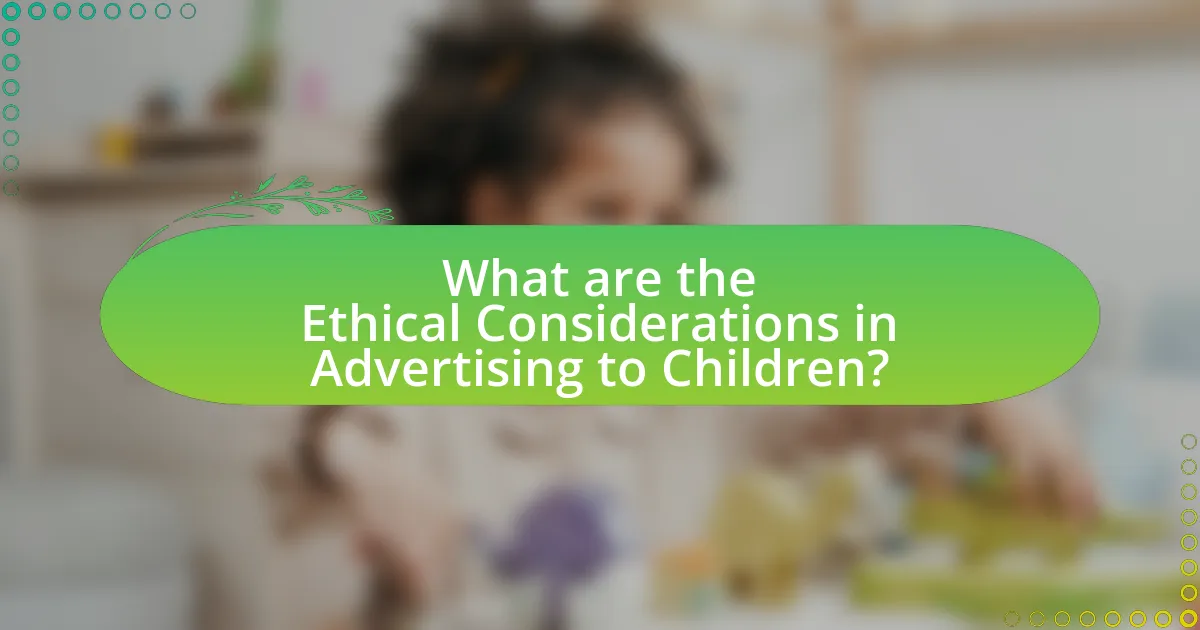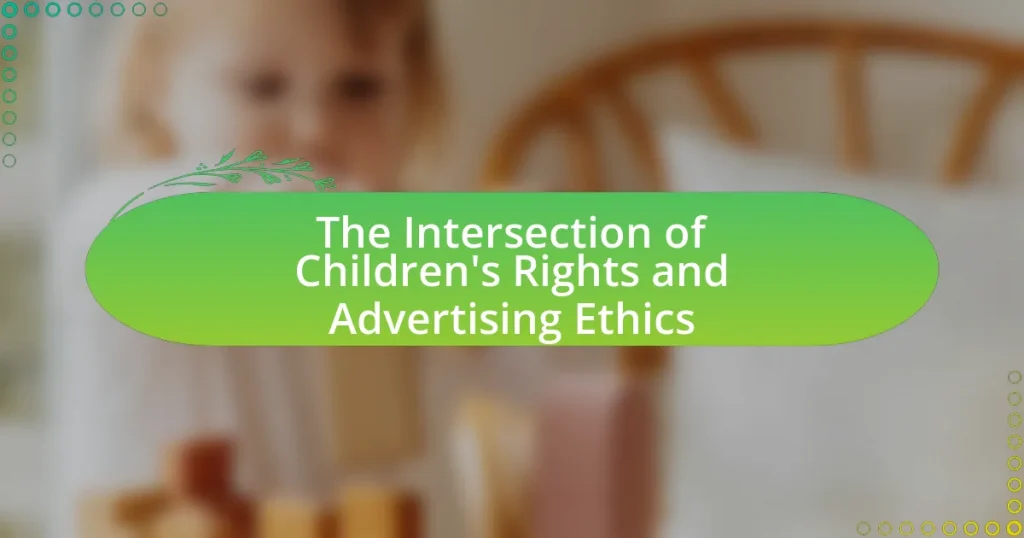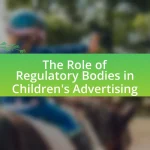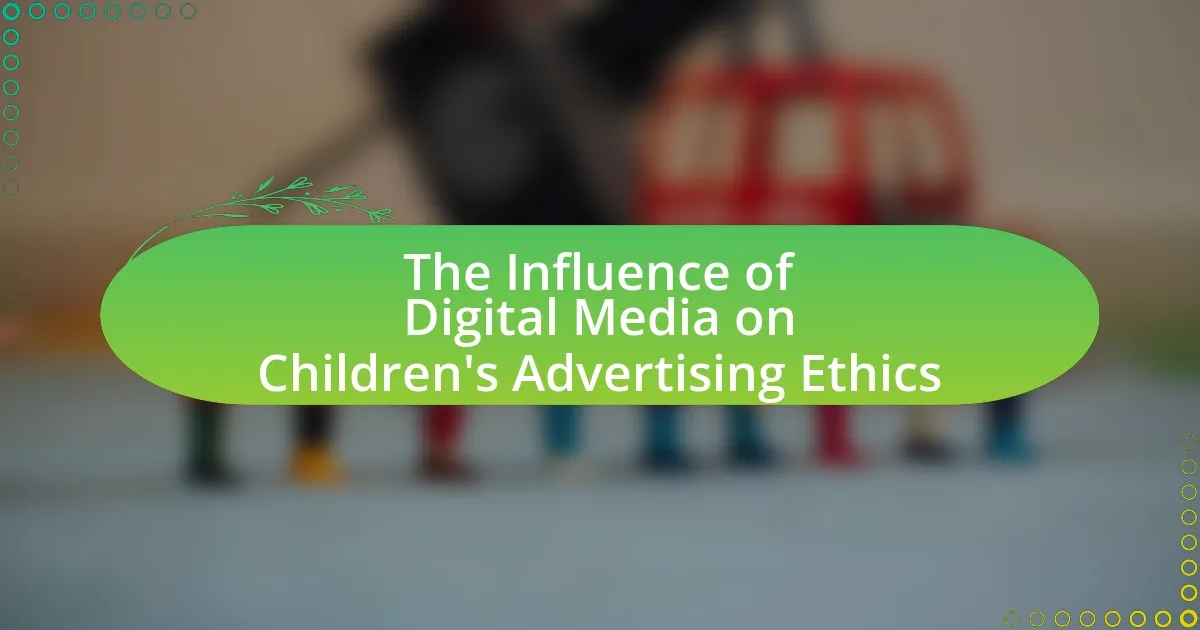The article examines the intersection of children’s rights and advertising ethics, emphasizing the need to protect minors from exploitative marketing practices. It outlines the framework established by the United Nations Convention on the Rights of the Child, which mandates the safeguarding of children’s well-being in advertising. Key topics include the global definition and protection of children’s rights, the ethical considerations in advertising to children, the potential harms of misleading advertisements, and the legal repercussions for unethical practices. The article also discusses strategies for advertisers to balance ethical standards with business objectives while promoting transparency and age-appropriate content.
What are Children’s Rights in the Context of Advertising?
Children’s rights in the context of advertising encompass the protection of minors from exploitative marketing practices that can manipulate their vulnerability. These rights are grounded in the United Nations Convention on the Rights of the Child, which emphasizes the need for children to be safeguarded from harmful content and to have their best interests prioritized. For instance, advertising aimed at children must not promote unhealthy lifestyles or products, as evidenced by regulations in various countries that restrict marketing of junk food to minors. Additionally, ethical advertising practices require transparency and honesty, ensuring that children can understand the messages being conveyed without being misled.
How are children’s rights defined and protected globally?
Children’s rights are defined and protected globally primarily through the United Nations Convention on the Rights of the Child (UNCRC), which was adopted in 1989 and has been ratified by 196 countries. This treaty outlines the civil, political, economic, social, and cultural rights of children, emphasizing their right to protection from exploitation, abuse, and neglect. The UNCRC establishes that children have the right to express their views, access education, and enjoy the highest attainable standard of health.
Countries that ratify the UNCRC are obligated to implement its provisions into national law and ensure that children’s rights are respected, protected, and fulfilled. Monitoring bodies, such as the Committee on the Rights of the Child, review state parties’ compliance and provide recommendations for improvement. Additionally, various international organizations, such as UNICEF, work to promote and protect children’s rights through advocacy, education, and support programs, reinforcing the global commitment to uphold these rights.
What international treaties address children’s rights?
The primary international treaty addressing children’s rights is the United Nations Convention on the Rights of the Child (UNCRC), adopted in 1989. This treaty establishes a comprehensive framework for the protection and promotion of children’s rights, including their right to education, health, and protection from exploitation. The UNCRC has been ratified by 196 countries, making it one of the most widely accepted human rights treaties in history, which underscores its significance in shaping national laws and policies related to children’s welfare.
How do national laws reflect children’s rights in advertising?
National laws reflect children’s rights in advertising by establishing regulations that protect minors from misleading and harmful marketing practices. For instance, many countries have enacted laws that prohibit advertising targeted at children under a certain age, ensuring that advertisements do not exploit their vulnerability or lack of understanding. In the United States, the Children’s Online Privacy Protection Act (COPPA) mandates parental consent for the collection of personal information from children under 13, thereby safeguarding their privacy in digital advertising. Similarly, the European Union’s Audiovisual Media Services Directive includes provisions that restrict advertising during children’s programming, aiming to limit exposure to commercial pressures. These legal frameworks demonstrate a commitment to uphold children’s rights by promoting ethical advertising practices that prioritize their well-being and development.
Why is it important to consider children’s rights in advertising?
Considering children’s rights in advertising is crucial because children are particularly vulnerable to manipulation and exploitation. Advertising can significantly influence their perceptions, behaviors, and choices, often leading to unhealthy consumption patterns and unrealistic expectations. Research indicates that children lack the cognitive ability to critically evaluate advertising messages, making them susceptible to misleading claims. For instance, a study published in the Journal of Advertising Research found that children under the age of eight do not understand the persuasive intent of advertisements, highlighting the need for protective measures. Therefore, respecting children’s rights in advertising not only safeguards their well-being but also promotes ethical standards within the industry.
What are the potential harms of advertising on children?
Advertising can harm children by promoting unhealthy behaviors, fostering materialism, and distorting their understanding of reality. Research indicates that exposure to advertisements for unhealthy food products contributes to poor dietary choices, leading to obesity and related health issues. A study published in the journal “Pediatrics” found that children exposed to food advertisements consumed more calories than those who were not. Additionally, advertising often encourages materialistic values, which can negatively impact children’s self-esteem and social relationships. The American Psychological Association has noted that such advertising can create unrealistic expectations and desires, leading to dissatisfaction and anxiety among children.
How can advertising influence children’s development and choices?
Advertising can significantly influence children’s development and choices by shaping their perceptions, preferences, and behaviors. Research indicates that children are particularly susceptible to advertising due to their cognitive and emotional development stages, which often lead them to accept promotional messages without critical evaluation. For instance, a study published in the journal “Pediatrics” found that children exposed to food advertisements are more likely to choose unhealthy snacks over healthier options, demonstrating how advertising can directly impact dietary choices and health outcomes. Furthermore, advertising often promotes materialism and unrealistic standards, which can affect children’s self-esteem and social interactions, as highlighted in the “Journal of Consumer Research.” Thus, advertising plays a crucial role in molding children’s values and decision-making processes.

What are the Ethical Considerations in Advertising to Children?
Ethical considerations in advertising to children include the protection of vulnerable audiences from misleading or harmful content. Children are less able to critically evaluate advertisements, making them susceptible to manipulation. Research indicates that children under the age of eight often cannot distinguish between entertainment and advertising, leading to potential exploitation. The American Psychological Association has highlighted concerns regarding the impact of advertising on children’s health, particularly in promoting unhealthy food choices, which can contribute to obesity and related health issues. Furthermore, ethical advertising practices advocate for transparency, ensuring that advertisements are clearly identified as such, and promoting positive social values rather than materialism.
What ethical principles should guide advertising aimed at children?
Advertising aimed at children should be guided by ethical principles that prioritize their well-being, including honesty, respect, and protection from exploitation. Honesty ensures that advertisements do not mislead children about the products being promoted, as children may lack the critical thinking skills to discern truth from exaggeration. Respect involves acknowledging children’s rights to privacy and not targeting them with manipulative tactics. Protection from exploitation means avoiding the use of fear, peer pressure, or other coercive strategies that could harm children’s emotional or psychological development. These principles align with guidelines established by organizations such as the American Psychological Association, which emphasizes the need for responsible advertising practices that safeguard children’s interests.
How do these principles align with children’s rights?
The principles of advertising ethics align with children’s rights by prioritizing the protection of minors from exploitation and harmful content. These principles advocate for truthful representation and the avoidance of manipulative tactics that could adversely affect children’s development and well-being. For instance, the United Nations Convention on the Rights of the Child emphasizes the right to protection from harmful influences, which supports ethical advertising practices that refrain from targeting vulnerable audiences with misleading or inappropriate messages. This alignment ensures that children’s rights are upheld in the context of advertising, fostering a safer environment for their growth and development.
What role do advertisers play in upholding ethical standards?
Advertisers play a crucial role in upholding ethical standards by ensuring that their marketing practices respect the rights and well-being of children. This responsibility includes adhering to guidelines that prevent misleading claims, exploitative tactics, and inappropriate content targeted at young audiences. For instance, the American Psychological Association emphasizes that advertising aimed at children should not exploit their inexperience or credulity. By following ethical advertising standards, such as those outlined by the Children’s Advertising Review Unit, advertisers contribute to a safer media environment for children, promoting transparency and accountability in their messaging.
What are the consequences of unethical advertising practices?
Unethical advertising practices can lead to significant consequences, including consumer mistrust, legal repercussions, and harm to vulnerable populations, particularly children. When advertisements mislead or exploit consumers, they erode trust in brands and the advertising industry as a whole, resulting in decreased sales and brand loyalty. For instance, a study by the American Psychological Association found that deceptive advertising can lead to a 20% decline in consumer trust. Additionally, companies may face legal actions and fines for violating advertising standards, as seen in cases where misleading claims led to lawsuits and regulatory scrutiny. Furthermore, unethical practices can negatively impact children by promoting harmful products or unrealistic standards, which can contribute to issues such as obesity and low self-esteem. Research published in the Journal of Advertising Research highlights that children are particularly susceptible to manipulative advertising, leading to long-term detrimental effects on their health and well-being.
How can unethical advertising impact children’s well-being?
Unethical advertising can significantly harm children’s well-being by promoting unhealthy behaviors and unrealistic expectations. For instance, advertisements that target children with junk food can lead to poor dietary choices, contributing to obesity and related health issues; the World Health Organization reports that childhood obesity has tripled since 1975, largely influenced by aggressive marketing strategies. Additionally, unethical advertising often perpetuates harmful stereotypes and materialism, which can negatively affect children’s self-esteem and mental health. Research from the American Psychological Association indicates that exposure to such advertising can lead to increased anxiety and depression among children, as they struggle to meet the unattainable standards set by these ads.
What legal repercussions exist for violating advertising ethics?
Violating advertising ethics can lead to various legal repercussions, including fines, sanctions, and lawsuits. Regulatory bodies, such as the Federal Trade Commission (FTC) in the United States, enforce laws against deceptive advertising practices, which can result in monetary penalties and mandatory corrective advertising. Additionally, companies may face civil lawsuits from consumers or competitors claiming damages due to unethical advertising. For instance, the FTC has imposed fines exceeding $5 million on companies for misleading advertisements, demonstrating the serious financial consequences of such violations.
How do Children’s Rights and Advertising Ethics Intersect?
Children’s rights and advertising ethics intersect primarily through the protection of minors from exploitative marketing practices. Advertising directed at children often raises ethical concerns regarding manipulation, as children may lack the cognitive ability to critically evaluate marketing messages. For instance, the American Psychological Association has highlighted that children under the age of eight are particularly susceptible to advertising, which can lead to unhealthy consumption patterns and materialistic values. This intersection emphasizes the need for ethical guidelines that prioritize children’s welfare, ensuring that advertising does not exploit their vulnerabilities.
What are the key conflicts between children’s rights and advertising practices?
Key conflicts between children’s rights and advertising practices include the exploitation of children’s vulnerability and the promotion of unhealthy behaviors. Advertising often targets children, leveraging their impressionability to encourage consumerism, which can undermine their right to protection from harmful influences. For instance, studies show that children exposed to junk food advertisements are more likely to develop unhealthy eating habits, contradicting their right to health and well-being. Additionally, the use of persuasive techniques in advertising can infringe upon children’s right to informed decision-making, as they may not fully understand the intent behind marketing messages. These conflicts highlight the ethical dilemmas faced by advertisers in balancing profit motives with the responsibility to uphold children’s rights.
How do commercial interests challenge the protection of children’s rights?
Commercial interests challenge the protection of children’s rights by prioritizing profit over the well-being of minors, often leading to exploitative marketing practices. For instance, advertising targeted at children frequently promotes unhealthy food choices, contributing to rising obesity rates among youth; the World Health Organization reported that childhood obesity has increased tenfold in the last four decades. Additionally, commercial entities may use manipulative tactics that undermine children’s ability to make informed decisions, as evidenced by studies showing that children under eight cannot distinguish between advertising and programming. These practices not only violate ethical standards but also contravene international frameworks like the UN Convention on the Rights of the Child, which emphasizes the need to protect children from harmful influences.
What examples illustrate the tension between these two areas?
One example illustrating the tension between children’s rights and advertising ethics is the marketing of unhealthy food products to children. Research shows that children are particularly vulnerable to persuasive advertising techniques, which can lead to poor dietary choices and health issues such as obesity. The World Health Organization has reported that targeted advertising of unhealthy foods contributes to the rising rates of childhood obesity, highlighting the ethical dilemma faced by advertisers who prioritize profit over children’s health. Another example is the use of digital marketing strategies, such as data collection and targeted ads, which can infringe on children’s privacy rights. The Children’s Online Privacy Protection Act (COPPA) in the United States aims to protect children’s personal information online, yet many companies find ways to circumvent these regulations, raising ethical concerns about the exploitation of children’s data for commercial gain.
How can advertisers balance ethical practices with business objectives?
Advertisers can balance ethical practices with business objectives by integrating responsible marketing strategies that prioritize consumer welfare while achieving profitability. This involves adhering to ethical guidelines, such as transparency and honesty in advertising, which fosters trust and loyalty among consumers. For instance, the American Psychological Association emphasizes the importance of protecting vulnerable populations, including children, from manipulative advertising tactics. By implementing age-appropriate messaging and promoting products that align with children’s developmental needs, advertisers can fulfill their business goals without compromising ethical standards. Research indicates that brands perceived as ethical often enjoy increased customer loyalty and long-term profitability, demonstrating that ethical practices can coexist with successful business outcomes.
What strategies can be implemented to promote ethical advertising?
To promote ethical advertising, companies can implement strategies such as adhering to strict guidelines that prioritize transparency, honesty, and respect for consumer rights. For instance, the American Advertising Federation emphasizes the importance of truthfulness in advertising, which helps build trust with consumers and protects vulnerable populations, including children. Additionally, organizations can engage in regular training for marketing teams on ethical standards and the impact of advertising on children, as highlighted by the World Health Organization’s recommendations on responsible marketing practices. By fostering a culture of accountability and ethical awareness, businesses can ensure that their advertising practices align with the principles of children’s rights and advertising ethics.
How can collaboration between stakeholders enhance children’s rights in advertising?
Collaboration between stakeholders can enhance children’s rights in advertising by creating a unified framework that prioritizes ethical standards and protects minors from exploitation. When advertisers, regulators, educators, and child advocacy groups work together, they can establish guidelines that ensure advertisements are age-appropriate, truthful, and do not manipulate children’s vulnerabilities. For instance, the International Chamber of Commerce’s Code of Advertising Practice emphasizes the need for responsible advertising to children, which can be effectively implemented through stakeholder collaboration. This collective effort can lead to more robust policies and practices that safeguard children’s interests, ultimately fostering a safer advertising environment.
What best practices should advertisers follow to respect children’s rights?
Advertisers should ensure that their marketing practices are transparent, age-appropriate, and do not exploit children’s vulnerabilities. This includes avoiding misleading claims and ensuring that advertisements do not encourage unhealthy behaviors or materialism. Research indicates that children are particularly susceptible to advertising messages, which can influence their preferences and behaviors significantly. For instance, a study published in the Journal of Advertising Research found that children under the age of 12 often cannot distinguish between entertainment and advertising, highlighting the need for clear labeling and responsible content. Additionally, advertisers should comply with regulations such as the Children’s Online Privacy Protection Act (COPPA), which mandates parental consent for data collection from children under 13, thereby protecting their privacy rights.
How can advertisers create age-appropriate content?
Advertisers can create age-appropriate content by understanding the cognitive and emotional development stages of their target audience. This involves tailoring messages, visuals, and themes to align with the interests and comprehension levels of specific age groups. For example, research indicates that children under the age of 8 may not fully understand persuasive intent, necessitating clear and straightforward messaging that avoids manipulation. Additionally, adhering to guidelines set by organizations such as the American Psychological Association, which emphasizes the importance of protecting children from exploitative advertising practices, can further ensure that content is ethical and suitable for young audiences.
What measures can be taken to ensure transparency in advertising to children?
To ensure transparency in advertising to children, regulations must mandate clear labeling of advertisements as such. This includes using distinct visual cues and language that children can easily understand, indicating that the content is promotional. Research by the American Psychological Association highlights that children often struggle to differentiate between entertainment and advertising, making clear labeling essential for informed decision-making. Additionally, implementing strict guidelines on the types of products advertised to children, particularly those that may be harmful, can further enhance transparency and protect young audiences.






